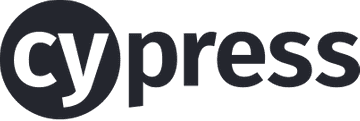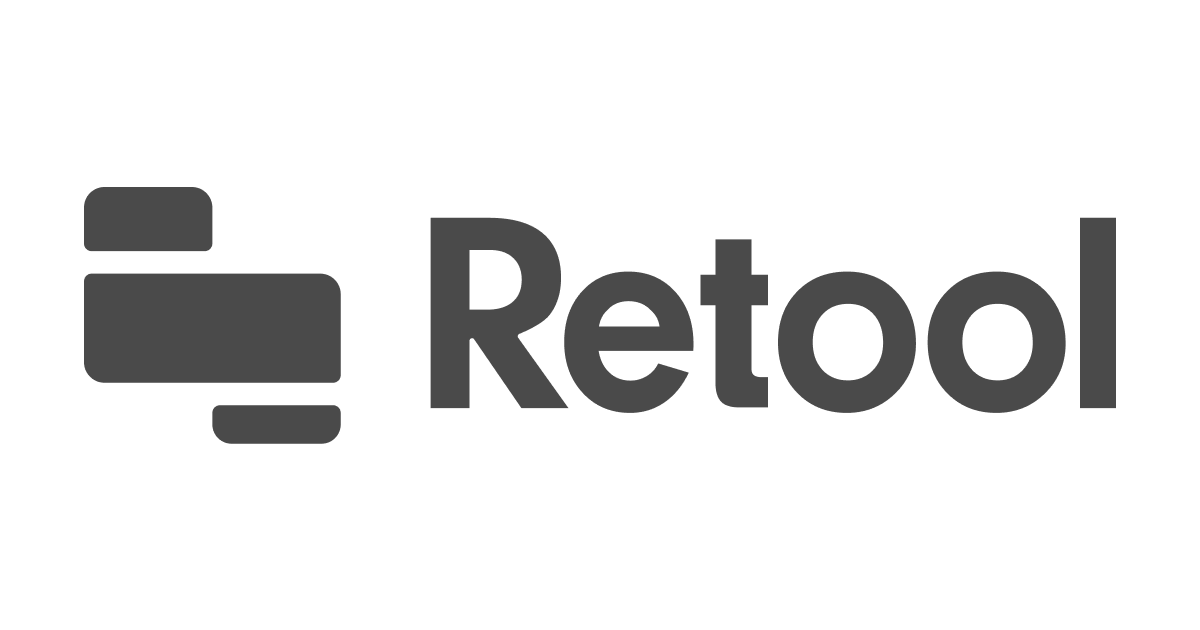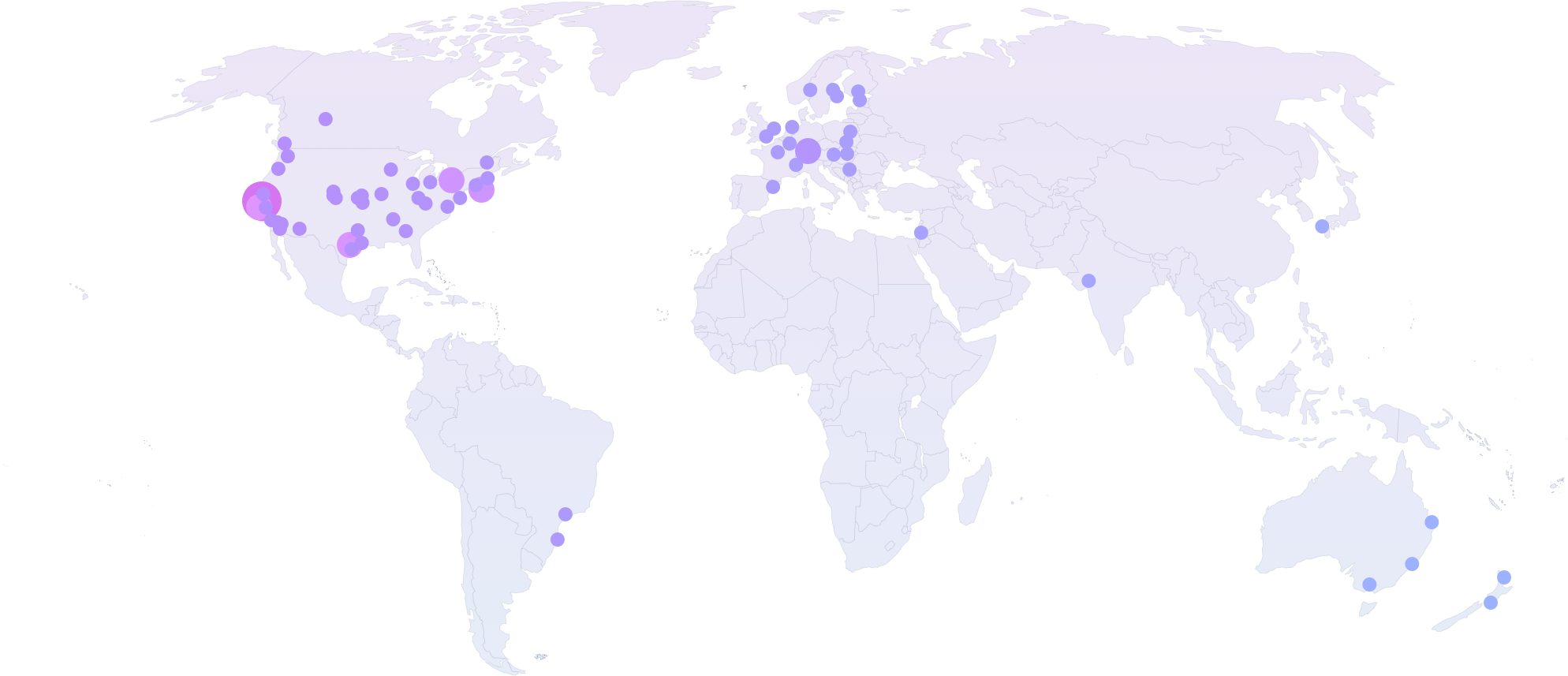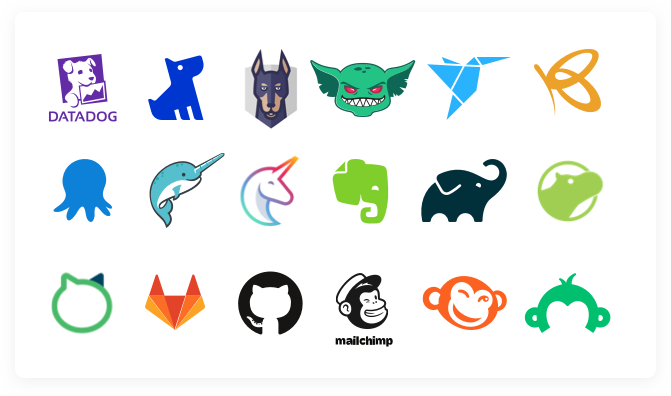The Anatomy of PLG SaaS
Explore the elements that make up the 300 best product-led growth SaaS companies

35 minutes
Introduction
In 2020, OpenView Partners identified nearly 300 companies that exemplify a product-led growth (PLG) strategy. We wanted to understand these PLG stars better, so we got started looking for trends.
Analysis
We examined the nearly 300 SaaS companies on OpenView's latest Product Led Growth Market Map. This spans publicly traded and private companies, small to large teams, B2B and B2C, and many product categories. Companies include Dropbox, Slack, Shopify, Calendly, Zoom, Canva, MongoDB, Evernote, Figma, Stripe, Typeform, Auth0, Okta, Gusto, Box, Loom, and Zendesk. Check out the market map for the rest.
In April/May 2021, we turned to Clearbit's enrichment data, which is pulled from over 250 public and private data sources, to analyze the firmographic profiles of these companies.
The report also refers to data from:
- Alexa and Semrush for website traffic information
- Crunchbase for insights on public companies, unicorns, and funding
- Clearbit's Logo API to help collect logos for our analysis
Why product led growth?
This strategy is linked to many of today’s most successful SaaS companies. According to OpenView:
- There are large public companies with a PLG model, including all of the top IPOs in 2019. The median enterprise value (EV) of PLG companies is 2X higher than the public SaaS index.
- PLG companies grow with a lower-than-average CAC payback.
- PLG has created more than $208B of market value to date.
Wait, what is Product Led Growth?
Very simply put, product-led growth (PLG) is a go-to-market motion that relies on a product (and its excellent user experience) to drive a company’s growth and all its funnel stages. The app itself, rather than ad dollars or sales outreach, is the engine.
The heart of product led growth is the end user, who can get into the product right away, experience real value, and not have to jump through any hoops to kick the tires. This is why PLG needs great user experiences: it's about helping the everyday human try a product, love it, and share it.
Organic discovery, viral loops, and network effects play important roles. This makes PLG a relatively cost-effective growth strategy, not having to rely on hiring more sales reps and spending a bigger marketing budget. PLG might require more R&D money early on to create a great product, but then it can scale with fewer team resource costs.
That said, PLG can be used in tandem with sales and marketing motions. Companies relying on product led growth are selective about where and when to deploy their toolbox of go-to-market motions — combining these in different ways for different journeys, including:
- Start with a popular free product, then layer on a sales-assisted track for enterprise leads.
- Begin as a sales-led company, then add a freemium or free trial product track a few years in.
- Use product to drive all net new revenue; only use sales and customer success teams to drive expansion revenue.
Okay, let’s see what these stars are made of...
Website traffic
When we look at the top 300 companies using a PLG strategy, can we find support for the idea that they attract a large volume of inbound traffic and use it to their advantage?
Alexa rank (and, what is Alexa rank anyway?)
Over half of the companies on the list have an Alexa Rank of 1-25k, meaning they are popular sites that get a lot of traffic.
Alexa Rank is a measure of a website's popularity. According to the folks at Alexa, they calculate this rank with a proprietary methodology combining a site's traffic and site visitor engagement over the previous 3 months.
The lower the Alexa rank, the more traffic a site is likely to get; a company with an Alexa rank of 3,000 is more popular than one with a rank of 25,000.
Estimated monthly traffic
Just how many website visitors are we talking when we say 25k Alexa rank?
We used Semrush data to cross-reference each company’s monthly website visit numbers. This, of course, is a very inexact method — as Alexa Traffic Rank is a relative measurement and we only looked at the domains on the PLG Market Map — but the exercise gives us a general sense of the scale companies in each cohort sees.
We estimate that the sites with a rank of 20k-25k get around 500,000 visitors per month, and increasing to 2.5 million for websites in the 5k-10k rank group.
Since so many companies on our list sit in the 1-25k band, we've added more granularity to the table below within that range. In the most popular tier, (1-5k rank), the average is a staggering 800 million visitors each month. (We're talking company domains like Amazon, Google, Zoom to give you an idea.)
| Alexa Rank (global) | Estimated average monthly traffic | # of Market Map companies |
| 1-5k | 810,311,838 | 94 |
| 5k-10k | 2,651,365 | 41 |
| 10k-15k | 1,620,588 | 18 |
| 15k-20k | 949,945 | 17 |
| 20k-25k | 562,509 | 13 |
| 25k-50k | 476,916 | 38 |
| 50k-100k | 229,266 | 31 |
| 100k-150k | 131,197 | 7 |
| 150k-250k | 118,270 | 17 |
| 250k+ | 29,704 | 24 |
This supports the idea that PLG is all about that strong top of the funnel: building a wide base of site visitors and then mastering the art of converting them.
OpenView's 2020 SaaS Product Benchmarks reports that the higher-growth PLG companies do a better job of converting that website traffic into free product users, than the lower-growth companies do. And for SaaS businesses with a freemium product or trial, getting users into that product is the single biggest source of leads.
Inbound traffic can come through product, content, community, network effects, and viral loops. The Product Benchmark report found that free leads coming from organic channels (like word of mouth, content, and social shares) tend to convert to paid accounts better than leads that come from paid marketing (SEM, paid social, retargeting, etc.). This is how small teams and small marketing budgets can drive outsize revenue.
Here's how Cypress leaned on community and product to gain their initial momentum:

One of the beautiful things about Cypress's go-to-market strategy is how naturally open source fuels our growth: our open source end-to-end test runner receives tens of thousands of monthly installs, which creates a steady flow of organic interest in our freemium Cypress Dashboard.
The evolution from open source user to Dashboard customer is very organic. Developers and QA engineers learn about our OSS product, learn the ropes through our documentation, and eventually adopt the Cypress Dashboard after learning about its advantages, through our docs.
This creates an amazing growth engine that doesn't require us to rely so heavily on traditional (and costly) SaaS sales and demand generation techniques.
The fact that our freemium product's success is inextricably linked to the success of our open source product creates an enormous incentive for our team to prioritize developer happiness with our open source product — which is obviously a huge win for all Cypress users!
Additionally, we love that developers and QA engineers talk so much about the tools and frameworks they're using. Word-of-mouth has been a huge, continuous boon to our business as more and more developers learn about Cypress.

Team size and website traffic
Higher-traffic companies tend to have more employees.
However, there are a few standouts of small, scrappy teams in the highest-traffic Alexa rank bands — like Retool (recently closing in on unicorn status with a near-$1 billion valuation):

Early on, we saw strong word-of-mouth growth from the core Y Combinator network, but knew we needed to expand our network to really grow. We thought about the phrases we wanted developers to say when they referred friends to Retool — settling on 'Retool is for developers' and 'Retool just works'.
Then, we focused on driving traffic to the site with content that conveyed those phrases. The two main types of content were:
1. Longform content about software we personally found interesting and thought could go viral on Hacker News. This drove 'Retool is for developers' awareness (along with lots of Hacker News comments and conversations).
2. Landing pages and docs that address specific technical pain points and showed how Retool has a good solution for common use cases like a Firebase or SQL admin panel. This targeted the message that 'Retool just works.'

Revenue trends
OpenView considers $10M ARR to be the point when the power of PLG kicks in — growth speeds up, and companies see the payoff of product development.
We found that the companies on the list have mostly surpassed the $10M revenue mark. If they haven’t, they tend to have small teams, averaging 23 people.
Annual revenue and team size
Broadly speaking, revenue is positively correlated with web traffic and team size. It looks as though no companies on the list with fewer than 250 employees have surpassed the $50M mark yet.
Let's look more closely at the company size make-up per revenue band:
Small teams can still pack a punch; there are companies with 60 employees generating $10-50M in revenue per year and one company with less than 250 employees generating $50-100M in revenue.

One company on the list stands out for outsize revenue and valuation relative to team size. The Atlanta-based Calendly has fewer than 250 employees, is nearing $100M in annual revenue, and is a unicorn valued at $3B.
Lastly, zooming in on that $10M - $50M annual revenue band, team size ranges from 60 to 300+ employees — with nearly 30% of this segment at the 150-employee mark.
Revenue and website traffic
Higher website traffic correlates with higher revenue. At the time of analysis, none of the companies with lower website traffic (Alexa rank <250k) have broken the $50M annual revenue mark.
There are a small handful of companies that are in the very highest bands of website traffic (1k-25k Alexa Rank and 25k-50k Alexa Rank), but only make $1M to $10M annual revenue. We see this as great potential and are excited to see how they make use of their large top of funnel.
Sales and marketing tools
Yes, there's sales in PLG companies
We looked at the companies’ technology tags and found that as revenue goes up, it's more likely that a company uses sales productivity tools at all.
Sales productivity tools
- CallRail - call analytics
- Chili Piper - call scheduling
- ClearSlide - sharing sales materials
- XANT (formerly InsideSales) - sales engagement
- MadKudu - predictive lead scoring
- Marchex - call and conversational analytics
- Peoplesoft Sales - Sales management and analytics
- SalesLoft - Sales engagement
- Pipedrive - CRM
- Salesforce - CRM
The number of tools used increases as well, based on the average number of sales productivity tools for companies using at least 1 tool in that category:
Of all of these companies, 80% use Salesforce. One can imagine that companies begin with a CRM — a streamlined tool like Pipedrive or a stalwart like Salesforce — as they start having to keep track of deals. (Recall the lack of sales productivity tools in the $0-1M segment.)
Then, they add tools as the sales organization grows, and there’s more need for sales management and efficiency.
These tools seem to kick in at $10-50M — coinciding with that magic $10M annual revenue mark!
So, when is it time to add sales to your product-led strategy?
Ted Ammon, a sales leader at Klaviyo, weighs in:
Customer Support is often there before Sales arrives in today's PLG companies. You will notice in support tickets, users begin asking 'sales-related' questions around inspirational use cases, competitive differentiation, plans and pricing, etc. When you start getting more and more of these questions from companies that fit your ICP and would qualify for paid plans — that's usually an early indicator that it's time to start thinking about layering sales into your org.
Sales, in a product-led business, is really an extension of your product. It's all about providing that next level of human guidance and support — meeting your customers where they are in their journey and unlocking paths for them to connect with your team when they need it. Sales just often happens to be on the front end of that journey.

Patrick Moran, Chief Revenue Officer at Calendly, describes a similar start in the evolution — from adding customer-facing reps to creating a more proactive sales motion:
In the first stage, customer-facing people start answering customers questions as support agents. At some point, these customer-success pros start proactively reaching out to very important customers: perhaps medium-sized customers with expansion opportunities, hot companies with a logo the PLG company wants on their site, or companies that squarely fit in the PLG company's ideal customer profile (ICP).
At the second stage, it makes sense for the high-touch, customer-facing pro to also help with renewals. After all, just because someone bought easily from a PLG company with their credit card doesn't mean they don't need to be convinced to renew next quarter.
At the third stage, PLG companies discover that their largest customers need a salesperson to help with legal contracts, explaining the product's value to finance, and so on. These salespeople often get very proactive with reaching out to larger companies once they sign up in the PLG motion to offer themselves up as resources to navigate complex buying cycles.

Marketing automation platform
Around 62% of companies have tech tags for marketing automation platform (with an email focus). Marketo and HubSpot are the two biggest players. The notable underdog in third place is Customer.io.
Larger PLG companies on the map are more likely to use Marketo over HubSpot.
Chat tools
Around 40% of the Market Map companies use chat tools. Smaller companies are more likely to have Intercom tags while the larger ones are more likely to have Drift.
In a high-traffic environment, chat tools can help convert visitors and help the sales team efficiently fast-track the best leads to AEs. Lower-value website visitors can chat with SDRs, interact with a chatbot, or just don’t see a chat box at all.
Video
About half of the companies on the list have a video tag on their site. YouTube, which is free, is the most commonly used tool. Wistia is nearly tied and is the #1 paid tool.
Around 40% of the companies with video tags use Wistia, also a member of PLG Market Map. It makes sense — Wistia is a marketing tool, not just a video hosting platform, with features for PLG marketers including email capture, analytics like heatmaps, and integrations with marketing automation platforms like HubSpot. This makes the tool useful for content marketing, amplifying event content, brand marketing, and product marketing to show off what the product can do.
PLG is all about marketing with your product, so you need the insights and control to get out of the way or drive action when necessary.
We give customers full control over their video experience. They get a player that can easily be integrated and made on brand, customizations that allow them to drive action, and analytics so they can figure out how to make the most impactful videos.

Location
Let’s look at where our companies are headquartered and what cities are PLG hotspots. (Don’t mind us while we pack our carry-ons and tapas appetites for Barcelona.) Companies on OpenView’s list were founded over a roughly 40-year time period (1980-2018), and we can see their location choices following broader tech industry patterns.
Note: Unless specified otherwise, locations refer to current headquarters for a company — which may differ from where the company was founded.

Companies on the list are based all over the world, from São Paulo, Brazil (Runrun) to Ahmedabad, India (SalesHandy) to the burgeoning scene of Tallinn, Estonia (Fleep, Veriff, and Toggl).
But there’s a big North American skew, with 78% headquartered in the US and 4% in Canada . In fact, half of all companies are headquartered in California with about 42% of total in the Bay Area.
When we move away from the tech hubs on the west coast of the US (Bay Area, Seattle, and Los Angeles), we see strong representation in the Boston area, New York, Atlanta, London, and Barcelona.
Going global: How headquarters location has changed over the last 40 years
The majority of companies on OpenView's are based in the US, including nearly all of the oldest ones. The only company currently headquartered outside of the US that has been around since the nineties is AVG in the Netherlands (1991).
Over time, HQ location has diversified somewhat. Newer companies in the US are more likely to be based in California than in other states.
What other countries were getting on the PLG train early?
There are a few standout countries that produced multiple PLG stars earlier than others—while many of the non-US companies on OpenView’s list showed up later. These companies from Canada and Australia were founded over the last two decades and use a PLG strategy today.
| Australia | Canada |
|
California dreamin'
Over time, California has become the biggest hub for the PLG companies on OpenView’s list, the balance tipping with companies founded in 2005-2010. Older US-based companies are actually more likely to be headquartered outside of California — in states like Texas, Arizona, Illinois, Virginia, Washington, and Massachusetts.
One part of California’s journey to become a PLG hub is San Francisco’s growing role in the tech industry. No companies founded before 2000 are headquartered in San Francisco. Instead, the older Bay Area companies are headquartered in Silicon Valley and Peninsula cities like San Jose, Sunnyvale, and Palo Alto.
But over time the balance shifted, and San Francisco is now the biggest PLG hub. Nearly one-third of all companies on the list are in the city proper.
Bring back the 90s: Original PLG
| Location | Company |
| Fairfax, VA | Roboform / Siber Systems (1995) |
| Austin, TX | Solarwinds (1999) — fun fact: founded in Tulsa, Oklahoma |
| Chicago, IL | Basecamp (1999) |
| Scottsdale, AZ | GoDaddy (1997) — hails from Baltimore, Maryland |
| Seattle, WA | Amazon (1994) |
| Waltham, MA | Constant Contact (1995) |
| Bay Area, CA (Silicon Valley & Peninsula) | SurveyMonkey (1999) — originally from Portland, OR TinyMCE (1999) Adobe (1982) Webex (1995) |
| Amsterdam, Netherlands | AVG (1991) |
Logos

The logos on the list span the rainbow, with evidence that blue is (still) a color of choice for software businesses.
Analysis by branding agency DeSantis Breindel found that more than 50% of the top 100 technology firms had blue elements in their logos. 99designs also found that blue is a staple brand color, showing up for 61% of top tech company logos.

Why is blue so popular? Blue is thought to communicate qualities like trustworthiness and reliability. Shaun Byrne, head of UX at Linktree also suggests that the rise of internet businesses and more transparency for consumers account for the flip from red as the primary brand color (signifying power, war, strength) to blue.
We're also seeing a shift from blue towards purple — with logos from approximately 43% of these companies in the blue-to-purple range of the rainbow, including "blurple" (e.g., Stripe, Appcues, Discord).
Why this color trend in what's considered such an innovative space? Here's Ethan Hackett, senior designer at Clearbit:
As humans, we have this powerful natural desire to associate similar things together. Most of the time that natural mechanism serves us pretty well, like helping our minds focus on more important tasks or problems.
As designers, we leverage and reinforce those associations all the time, as they play into how we feel about colors in general. Blues tend to be very popular because they're 'safe' and already a lot of associations with tech companies.
A case could be made that any logo could have been any other color. However, logos and branding are rarely created in vacuums.

In this sea of PLG logos, we also couldn't help but notice the 18 (non-human) creatures popping up — from the more popular (cats, dogs, and elephants, oh my!) to the imaginary (unicorn and gremlin) to the seemingly imaginary but very real (hello, narwhal).

Amongst these creature-y logos, developer and product tools is the top product category, accounting for nearly half the group at 44%.
IPOs
Of the 300 companies on the OpenView list, 43 companies are public as of May 2021 (including companies that were delisted upon having been acquired by a public company).
This group includes Shopify, Docusign, Atlassian, Zendesk, and DigitalOcean, as well as impressive outliers Zoom and Snowflake, which went public in 2019 and 2020 respectively.
Category of PLG software to IPO
The most common IPO’d product category is Developer and Product Tools. While companies in this category make up 30% of the overall OpenView PLG list, they make up 40% of public companies.
What are these companies getting right? Sam Richard from Openview points to the need to focus on serving the end user from day one:
Developers are a tough pack to sell to. To be successful in this category, you need to fully understand your users — their needs and motivations. Developers want to get into a quality product quickly, pay for what they use, and be thoughtful about ways that they can expand their usage. I look to developer-first companies to innovate the most with regards to PLG.

Time to IPO
Many public companies on the list IPO’d at 8-10 years old, while others took closer to 20 years, like SurveyMonkey, Solarwind, and Qualtrics.
Have valuations at IPO gotten bigger over time?
Generally, we see larger valuations at IPO in more recent years. Valuations of $5-25 billion started showing up in 2018; before then, valuations rarely hit $2-5 billion. 2019 was a big year for PLG IPOs.
Google is an exception with its $23 billion valuation in 2004, six years after it was born. 2020 is also an exception, because 2020.
Unicorns
The OpenView list has quite a few unicorns (valuation over $1B) and a number of "emerging unicorns" (between $500M - $1B valuation).
Most of these unicorns are located in the Bay Area, and only a small handful are outside of the US.
🦄 Emerging unicorn spotlight (between $500M and $1B valuation)
- Hootsuite (Vancouver, Canada)
- Campaign Monitor (Nashville, Tennessee)
- Contentful (Berlin, Germany)
- DataStax, Retool, Tray.io, Ironclad, Algolia (Bay Area, California, US)
🦄 Scrappy unicorns
Developer & Product Tools is the most common category for unicorns on the list (examples include Gitlab, Zapier, and Amplitude). We see the most emerging unicorns in this group, followed by the Back Office & Operations and Customer Engagement categories.
And here's a quick look at common Crunchbase industry name tags for all Unicorns, using MonkeyLearn's Word Cloud Generator:

Most unicorns on the OpenView list were founded between 2010-2015, while most unicorns that have exited were founded between 2000-2010.
Funding
A quick look at company funding:
Companies that have received over $100M in funding are more likely to be headquartered in the Bay Area than not.
Funding raised in private companies
Many companies that haven’t gone public have raised late-stage capital, while plenty of others stopped at earlier rounds like seed and Series A.
B2B or not-2B?
A product-led growth strategy requires relentless focus on the end consumer, making it ideal for B2C or "prosumer" (professional consumer) markets. These self-serve products grow quickly with relatively little overhead, thanks to their optimized entry points and network effects.
We’re obviously fans. But we don’t mean to suggest that it’s a silver bullet—more often, PLG is a component of a broader portfolio of GTM and monetization strategies.
A successful B2C SaaS that relies on a PLG strategy may need to go upmarket to continue to scale and reach the upper SaaS echelons. With that often comes sales teams and more marketing.
Here's Jason Chen on Slab's timing for the transition:
A good enough product can sell itself and that's what we focused on building all the way to 7 figures in revenue. This has to be led by a committed founder—no one else can have the product knowledge and business context to explore all the parts of the user experience to get something that works. After finding success, you can hire someone to replace yourself.

Nearly all of the companies on OpenView’s list are now B2B, and plenty of them started as B2C and layered in a B2B or enterprise offering later in life. (Some, like Logz.io, go the other way.)
Dropbox and Frame.io are examples of companies that used PLG to build their initial userbase and then brought in B2B sales to drive expansion revenue. Frame.io’s video collaboration tool focused on serving consumers and prosumers for three years before they built out an enterprise sales motion and used a Series C round to formalize and expand their efforts to move upmarket (while continuing to invest in product tracks).
Brianne Kimmel, founder of Worklife Ventures, explains that it's easy for companies to get addicted to successful self-serve growth and stay in their comfort zone, but that “often times, focusing strictly on PLG puts a company at risk of overlooking the potential value of expansion revenue, and that's where you really start to see meaningful traction with SaaS companies." She adds, “Sales teams … make sure no one is leaving money on the table."
Clearbit’s data on sales tool usage trends supports this idea, showing that companies with more revenue and more employees are more likely to use sales productivity tools. The larger they get, the more likely to have CRMs like Salesforce and Pipedrive, as well as multiple additional tools like Chili Piper, MadKudu, and SalesLoft.
How does a company transition into a hybrid self-serve and sales approach?
Here's Patrick Moran, CRO at Calendly again with his number one recommendation for how to approach this major adjustment:
A few of us on the Calendly team come from PLG companies that have added sales teams — companies like New Relic, Glassdoor, InVision, and more. We compared notes and agree that Calendly is adjusting quite well to this phase of combining product-led and sales-assisted cultures.
Perhaps having people on staff who've 'seen the movie before' and know what to look out for is half the battle. Much of the challenges PLG companies face when adding sales are interpersonal ones. For example, PLG product managers who've never worked with sales before may be surprised that new salespeople are bringing one-off feature requests to them from Fortune 100 customer prospects. Or, conversely, salespeople who've only worked in sales-led companies may be shocked that PLG product managers aren't as eager to take their feedback as they're accustomed to.
Leading that transformation work of helping each team learn about what motivates the other team, what they struggle with, and where they're coming from is my number one recommendation for PLG companies adding a sales team.

How does this shift specifically change marketing's job?
Edward Ford, Director of Marketing, describes how his team had to rethink almost everything after Supermetrics moved from a sole self-serve funnel to layering in a sales-assisted funnel:
As a marketer, you need to start thinking about which path makes sense for which prospects, from both a business and customer perspective — whilst optimizing those deciding criteria over time based on data.
At first, take time to build the foundations (like onboarding flows and enablement resources) since your sales team is most likely going to grow very rapidly.
You will need to rethink your marketing KPIs and incorporate something like MQLs/SQLs or sales-assisted pipeline too. In terms of the big picture, you should also be aligned on forecasting since you'll be moving what was traditionally self-serve pipeline into the sales-assisted funnel.
A final point to consider is that you're not purely driving direct revenue through a self-serve funnel anymore, but a big part of your job is putting your sales team in a position to be successful; every time your sales team hits quota it's a win for the marketing team too.

Considering sales wins as marketing wins is in line with advice from Jeff Hardison, Head of Product Marketing at Calendly. His suggestion on how to be a successful marketer for a growing PLG company with a sales motion: using applied empathy to actively align and serve different teams for the whole company's growth:
When you're a marketer in a PLG company, you often answer to the three most powerful people in the company: the CEO, chief technology officer, and chief product officer. Being like them — data-driven and experimental — will get you far.
However, when a sales team is added — for the first time — a PLG marketer has to answer to someone who thinks differently. Perhaps the sales leader doesn't just need free signups, but also large companies who want a demo. Perhaps the sales team doesn't just need you to be adept at updating spreadsheets, but also presenting plans in front of a quick-witted sales force.
The best marketers in PLG companies that go upmarket are self-aware, re-evaluate whether their talents are best suited for their employer's next stage, and grow to learn how to balance the needs of two masters: PLG and sales-assisted revenue. One tiny startup CEO's amazing growth hacker is another large company CEO's chief frustration because the marketer can't get along with the new VP of sales.
A hybrid marketer's greatest superpower is 'applied empathy' for seemingly disparate sales and product teams. They ask, 'How can we all work together to help our company grow?'

What does PLG look like inside companies?
You've gotten a broad look at product led growth companies as a group. But what does being product-led mean for the people — their jobs and teams?
We asked a few folks from the OpenView list to tell us about their role and what product-led growth looks like at their company. Three themes emerged. Product-led roles and teams move fast and fix things. They:
-
experiment: testing, iteration, failing, and learning are all core parts of the job
-
work across the user journey: the user journey and business funnel, from acquisition through retention, is their canvas. Working with this holistic view requires being cross-functional and collaborative.
-
focus on the customer: the mission here is to create value and provide smooth, relevant experiences for the customer, especially the end user
Here's a peek at what PLG looks like inside Unbounce, from product and marketing:
PLG rapidly experiments by releasing 'Pretotypes', using our own Unbounce landing page tools, in order to assess how much demand there is in the market for a range of ideas. We test more than one concept at a time and then guide our investments in the direction of the strongest signals.
We also optimize for both conversion rate and intelligence with a one field sign-up that we enrich with Clearbit.

At Unbounce, Product Marketing sits within a unique department — Strategic Growth — dialed in on accelerating growth through go-to-market strategy, identifying and armoring market position, and seeking opportunities to differentiate in how we connect with our customers.
Putting Product Marketing & PLG together is like building your users the perfect mech suit, and then strapping some custom rocket boosters to it. Not only have you developed the best experience for a user's needs, you've launched with a message that's got just the right kinda flair.
The PLGxPMM crossover team is a small team of subject matter experts that moves quickly and makes decisions with speed and customer value discovery at the center of what we do. While working lean, the PLG philosophy pushes me to stay outside the box in my work

Product led growth also is on the rise as a specific expertise, with the term appearing in job titles, team designations, and LinkedIn bios.
Let's hear from members and leaders of PLG-specific teams at Contentful, Algolia, and Smartsheet on how product led growth informs their role:
Contentful's Growth team is a cross-functional unit — including members from Marketing, Product and Engineering — primarily responsible for growing our self-service Team tier revenue. While other teams own one or two parts of our funnel, we take a holistic view and engage wherever we think we can make the most impact, devising and implementing experiments to move the needle on key funnel metrics.

Here at Algolia I'm responsible for Growth, which means two key areas of focus:
(a) DevRel (developer relations) creating value for our community, through relevant and actionable developer-to-developer content (how to do X with Y), coding templates and examples, digital meet-ups, coding sessions and so on.
And (b) product-led growth which means acquiring, activating and making users successful in the product as fast as possible, delivering frictionless onboarding through to great paying customer experiences that accelerate the value from Algolia.
We measure success of our growth by the number of active projects (projects with running search operations over 3 months) we generate every month. That’s our North Star metric.

As Head of PLG at Smartsheet, I am responsible for the whole digital customer journey and managing two teams: Growth Product and Digital Sales.
Growth Product Team consists of three squads: Onboarding and Engagement (KPIs: Activation. Engagement), Virality (KPIs: Viral Acquisition), Revenue (KPIs: Booking from PQLs, Upsells, Conversion Trial to Paid, Retention).
Digital Sales Team manages cross-channel customer lifecycle communications (Email, Push Notifications, In-Product Messages).
Being able to unlock massive growth opportunities by running data driven experiments, learning from them and solving customers' problems is exciting.

Looking for a PLG job?
With the rise of product led growth, people's interest in working for PLG companies has also increased. Upon noticing this trend, Jack Miller, Head of Growth at Chattermill, built the job board, Product Led Growth Jobs — showing jobs across the 3 main functions driving PLG.
The rise in Product Led Growth has been fascinating to watch unfold across a spectrum of companies. This shift has increased the need for Product Led Growth skills, mindset and DNA to create completely new roles and opportunities both within companies and functions.
We are still in the early days of PLG; as it becomes the GTM motion and companies are fully oriented around it I fully expect we'll see Product Led Growth roles and skillsets become required across entire organisations and functions.

